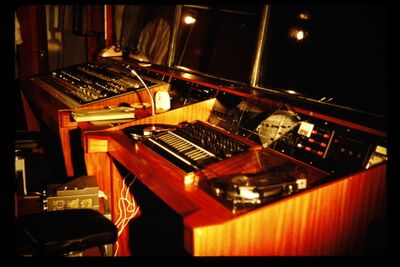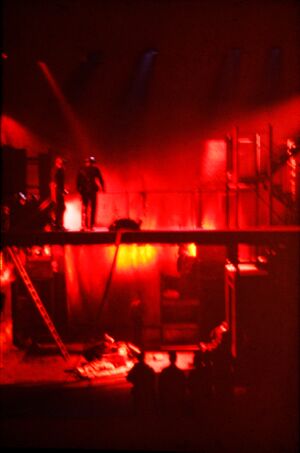Difference between revisions of "Power and Control"
(Created page with "''On theatre and concert stages, good sound requires the ability to produce the required sound in the right place, under the control of the sound engineer. The fundamental met...") |
|||
| Line 1: | Line 1: | ||
| − | ''On theatre and concert stages, good sound requires the ability to produce the required sound in the right place, under the control of the sound engineer. The fundamental methods for achieving this were set in the 1960s.'' | + | ''On theatre and concert stages, good sound requires the ability to produce the required sound in the right place, under the control of the sound engineer. The fundamental methods for achieving this were set in the 1960s.'' |
| + | [[File:IO2 D.09 4.JPG|400px|thumb|left|Theatre sound control with mixing desk and turntables, around 1970]] | ||
| + | |||
In Germany after the Second World War, there was a great investment of public money into rebuilding the theatres that had been destroyed in the bombing. These theatres were equipped with the latest technology, including sound. A control room was placed at the back of the auditorium, with clear sight of the stage, staffed by the Tonmeister and his team. In London’s West End in the 1950s and 1960s, the situation was quite different: sound didn’t have its own department, it was operated by a junior member of the stage management team from backstage, using a panatrope, or later, reel-to-reel tape machines (D.08). The role of the sound designer was only just emerging. | In Germany after the Second World War, there was a great investment of public money into rebuilding the theatres that had been destroyed in the bombing. These theatres were equipped with the latest technology, including sound. A control room was placed at the back of the auditorium, with clear sight of the stage, staffed by the Tonmeister and his team. In London’s West End in the 1950s and 1960s, the situation was quite different: sound didn’t have its own department, it was operated by a junior member of the stage management team from backstage, using a panatrope, or later, reel-to-reel tape machines (D.08). The role of the sound designer was only just emerging. | ||
| − | The musical ''Blitz!'', by Lionel Bart, opened in London in 1962. Set in the East End of London during the aerial bombings of the Second World War, the show – scenery, lighting and sound – was on a more massive scale than anything that had been seen in the West End before. The sound designer and operator, David Collison, argued that he needed to be in the auditorium to control the sound, so he could see and hear the show and integrate the very complex sound plot into it. No West End sound operator had ever been located front of house before, and the producer initially refused, but eventually three seats at the side of the auditorium were allocated, when it became clear the huge, mobile set pieces and cast of 40 actors left no room backstage for the sound operator. | + | The musical ''Blitz!'', by Lionel Bart, opened in London in 1962. Set in the East End of London during the aerial bombings of the Second World War, the show – scenery, lighting and sound – was on a more massive scale than anything that had been seen in the West End before. The sound designer and operator, David Collison, argued that he needed to be in the auditorium to control the sound, so he could see and hear the show and integrate the very complex sound plot into it. No West End sound operator had ever been located front of house before, and the producer initially refused, but eventually three seats at the side of the auditorium were allocated, when it became clear the huge, mobile set pieces and cast of 40 actors left no room backstage for the sound operator. |
| + | [[File:IO2 D.09 5.jpg|300px|thumb|right|Scene from the musical Blitz!]] | ||
| + | |||
The sound for ''Blitz!'' was innovative in other ways. Fourteen speakers were placed around the stage and auditorium, and Collison designed a custom mixer, build by Stagesound, to allow him to send sound from any of the three tape recorders, via four master faders, to any combination of the speakers. The flexibility of this system was unique in the West End at this time, allowing Collison to move sound around the stage – for example, panning the sound of an underground train across the stage. A separate sound system handled the reinforcement of the singers, with microphones placed along the front of the stage. While there was much further development to come over the following decades, at the start of the 1960s the sound for Blitz! was the template for theatre sound as we know it now: the operator in the auditorium, able to hear what the audience hears; a speaker system that can locate sound spatially with precision; multiple sound sources mixed and fed to any combination of speakers. | The sound for ''Blitz!'' was innovative in other ways. Fourteen speakers were placed around the stage and auditorium, and Collison designed a custom mixer, build by Stagesound, to allow him to send sound from any of the three tape recorders, via four master faders, to any combination of the speakers. The flexibility of this system was unique in the West End at this time, allowing Collison to move sound around the stage – for example, panning the sound of an underground train across the stage. A separate sound system handled the reinforcement of the singers, with microphones placed along the front of the stage. While there was much further development to come over the following decades, at the start of the 1960s the sound for Blitz! was the template for theatre sound as we know it now: the operator in the auditorium, able to hear what the audience hears; a speaker system that can locate sound spatially with precision; multiple sound sources mixed and fed to any combination of speakers. | ||
Latest revision as of 19:03, 18 February 2023
On theatre and concert stages, good sound requires the ability to produce the required sound in the right place, under the control of the sound engineer. The fundamental methods for achieving this were set in the 1960s.
In Germany after the Second World War, there was a great investment of public money into rebuilding the theatres that had been destroyed in the bombing. These theatres were equipped with the latest technology, including sound. A control room was placed at the back of the auditorium, with clear sight of the stage, staffed by the Tonmeister and his team. In London’s West End in the 1950s and 1960s, the situation was quite different: sound didn’t have its own department, it was operated by a junior member of the stage management team from backstage, using a panatrope, or later, reel-to-reel tape machines (D.08). The role of the sound designer was only just emerging.
The musical Blitz!, by Lionel Bart, opened in London in 1962. Set in the East End of London during the aerial bombings of the Second World War, the show – scenery, lighting and sound – was on a more massive scale than anything that had been seen in the West End before. The sound designer and operator, David Collison, argued that he needed to be in the auditorium to control the sound, so he could see and hear the show and integrate the very complex sound plot into it. No West End sound operator had ever been located front of house before, and the producer initially refused, but eventually three seats at the side of the auditorium were allocated, when it became clear the huge, mobile set pieces and cast of 40 actors left no room backstage for the sound operator.
The sound for Blitz! was innovative in other ways. Fourteen speakers were placed around the stage and auditorium, and Collison designed a custom mixer, build by Stagesound, to allow him to send sound from any of the three tape recorders, via four master faders, to any combination of the speakers. The flexibility of this system was unique in the West End at this time, allowing Collison to move sound around the stage – for example, panning the sound of an underground train across the stage. A separate sound system handled the reinforcement of the singers, with microphones placed along the front of the stage. While there was much further development to come over the following decades, at the start of the 1960s the sound for Blitz! was the template for theatre sound as we know it now: the operator in the auditorium, able to hear what the audience hears; a speaker system that can locate sound spatially with precision; multiple sound sources mixed and fed to any combination of speakers.
The period was also important for rock concert sound. Until the late 1960s, bands used amplifiers for their guitars, and vocal mics. With the amps at the back of the stage, the vocals could not be turned up without causing feedback, restricting the loudness of the whole system. Column speakers, with several drivers, were added, but the low power of the available amplifiers was still a limitation. In 1965, the Beatles played the Shea Stadium in New York – the first stadium rock concert – and were completely drowned out by the screaming crowd. In the UK, Charlie Watkins of WEM was seeking a higher-powered amplifier. RCA had recently introduced a 100W transistor amplifier, and Watkins, in conjunctions with his colleagues, had the idea to combine up to ten of the amplifiers, to achieve a 1000W output. He tested the new amplifiers at the 1967 jazz festival in Windsor, UK, driving ten of his largest speakers, plus 20 column speakers, plus high frequency horns, and bass speakers. It was the breakthrough he’d been looking for.
News spread rapidly. Watkins received requests for systems from Rod Stuart, Pink Floyd, and many others. When Bob Dylan gave a concert at the Isle of Wight festival in 1969, he insisted on buying the sound system afterwards. In the same year, Watkins provided sound for the Rolling Stones in London’s Hyde Park, mixing it from the side of the stage. Mick Jagger asked Watkins to tour with the band, saying the mixing position should be in the middle of the crowd; Jagger even had a special scaffolding platform designed for the sound control position. At around the same time, Watkins had introduced on-stage foldback, so bands could hear themselves and each other clearly.
As with theatre sound, by the end of the 1960s the key components of sound for live music were in place: backline for the guitars; main PA speakers with bass, mid and high cabinets each optimised to the task, driven by powerful amplifiers; the main mix for the audience controlled from a front of house position; a separate foldback mix for the band. On both the theatre and the concert stage, the late 20th century saw the development and refinement of sound production, with many technical innovations, but based on templates set in the 1960s.

